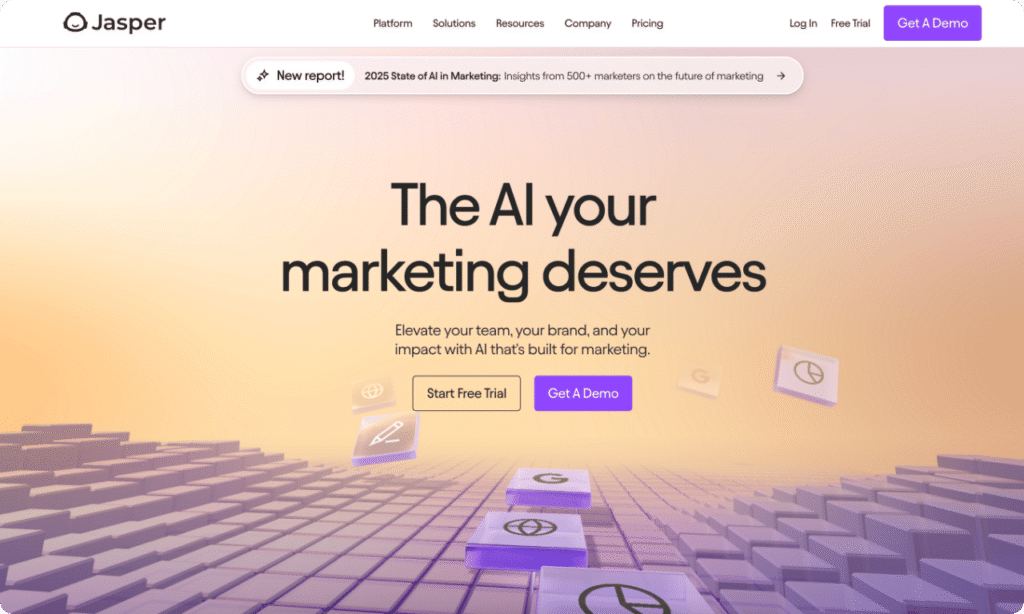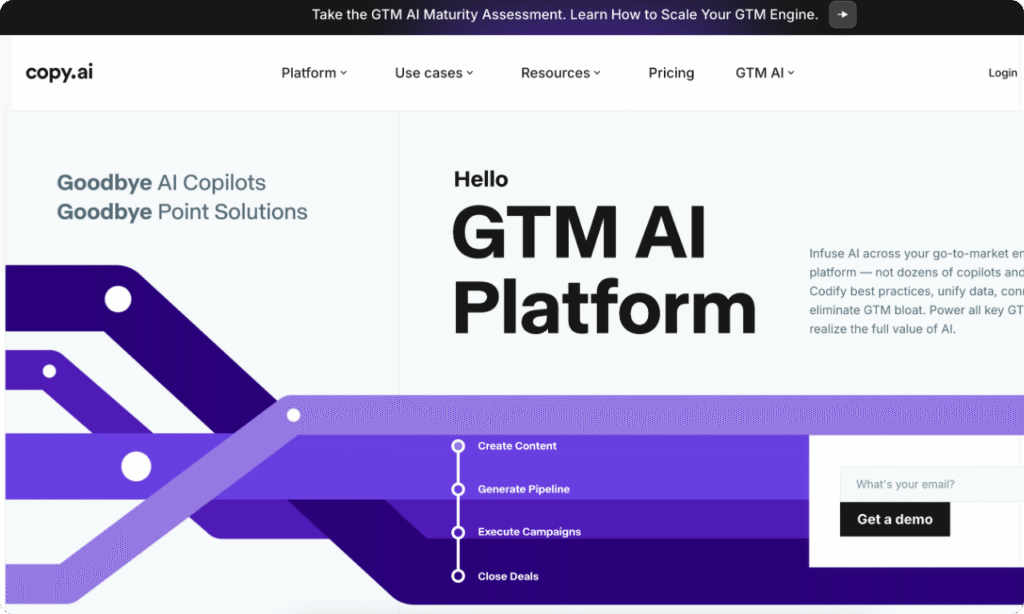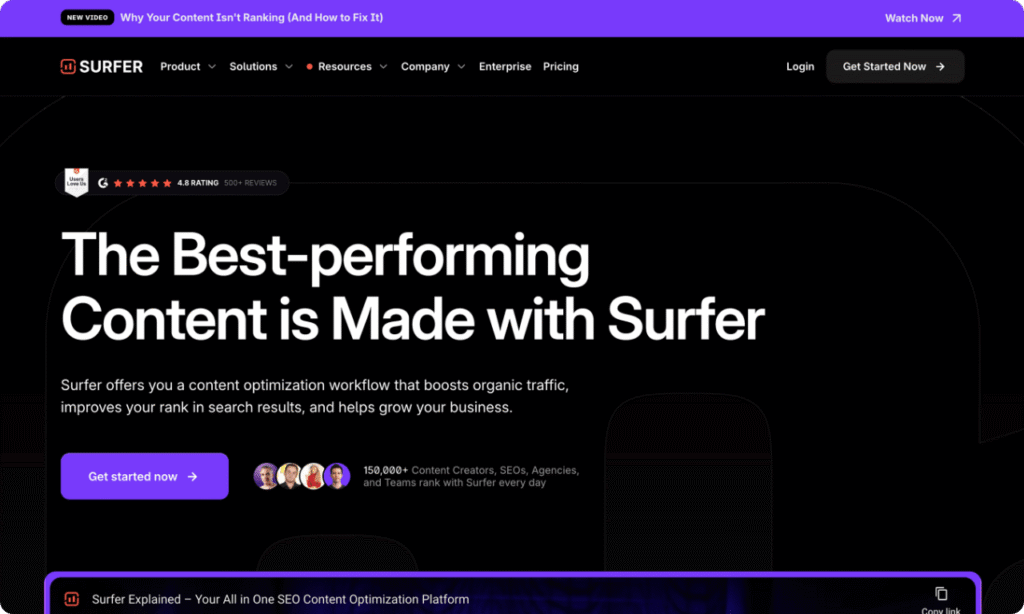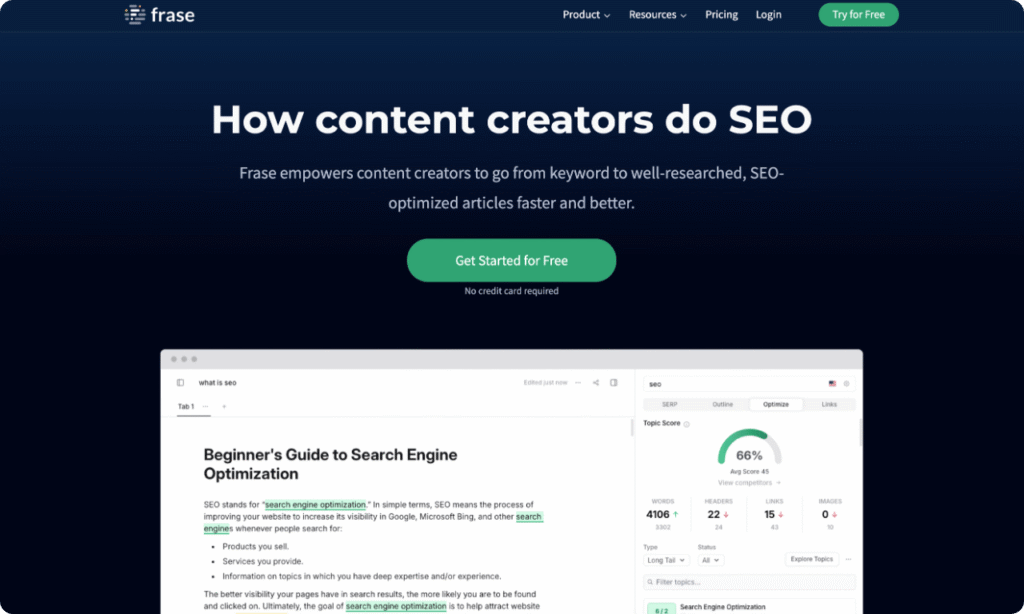AI content creation has changed the way we produce digital content. These innovative tools help content creators cut their production time by half while producing twice as much content. This makes a huge difference for anyone who has ever spent four hours writing a simple 500-word blog post.
The traditional way of creating content is becoming obsolete. A recent survey shows that 75% of marketers use AI tools in some capacity, and 19% of businesses rely on them specifically for content generation. The results speak for themselves. The right AI tools can change your workflow completely, whether you need content for blog posts, social media, or marketing materials.
AI Tools That Aid Content Creation
Our team has tested dozens of platforms to find the most effective AI content creation tools for 2025. ChatGPT leads the market with a 40% share. Specialized platforms like Jasper AI excel at marketing copy, while Synthesia creates realistic videos without needing cameras or actors. Our selection includes Frase, which combines content creation with SEO research, and DALL·E 3, which turns text descriptions into stunning illustrations.
Here are the 12 best AI content creation tools that provide real value and help you be proactive in this competitive landscape.
ChatGPT

ChatGPT burst onto the scene in late 2022 and became the life-blood of AI content creation. The platform attracted one million users in its first week. By February 2023, active users skyrocketed to over 100 million, making it a powerhouse in the digital world.
ChatGPT key features
ChatGPT works as a conversational AI assistant that runs on OpenAI’s large language model. The system creates human-like text and stands out with these features:
- Natural language processing: The AI understands context and responds like a human would in conversation.
- Memory capabilities: Unlike basic chatbots, ChatGPT keeps track of earlier conversation points and refers back to them when needed.
- Multi-format content generation: The system helps write blog posts, code, outlines, and adapts content for different platforms.
- Tool integration: Users with paid subscriptions can access web browsing, image analysis, and document processing features.
The free version (GPT-3.5) gives content creators plenty of tools to work with, though prompts are limited to 2048 characters.
ChatGPT pros
Companies in the US saved between $76,449 and $107,029 in 2023 by using ChatGPT. The platform is a great way to get help with:
- Research and brainstorming that explores different views and ideas
- Adapting content for various platforms
- Breaking down long articles or transcripts
- Creating responses that match specific needs
ChatGPT acts as a round-the-clock knowledge hub that saves substantial time in content research and creation.
ChatGPT cons
ChatGPT has some clear drawbacks for content creators. The system’s knowledge stops at 2021, so it can’t help with recent events. It sometimes makes up information that needs fact-checking.
These limitations also matter:
- Studies show almost 60% of ChatGPT’s output might be plagiarized
- Writing often follows similar patterns and needs heavy editing
- Human writers still outperform it in creativity and original thinking
- Users need to think about data privacy and potential bias in responses
Content creators looking for AI tools will find ChatGPT useful, but they need human oversight to ensure their work stays accurate, original, and high-quality.
Jasper AI

Jasper AI is a purpose-built AI content creation platform that marketing teams love. More than 100,000 copywriters and marketers trust the platform. The 3-year old platform naturally fits AI into every marketing workflow.
Jasper AI key features
Jasper packs powerful tools that make it different from regular AI assistants:
- Brand Voice technology lets users create consistent content by scanning uploaded documents or entire websites
- 50+ specialized templates help create blog posts, social media content, ads, and product descriptions
- AI Image Suite creates and edits custom images at scale
- Jasper Chat gives users an accessible interface to work with AI
- Chrome Extension brings Jasper’s capabilities wherever you browse online
- Knowledge Base integration lets users upload company assets and information
Jasper supports over 30 languages and combines smoothly with Surfer SEO, Grammarly, and Copyscape. This creates a detailed content ecosystem.
Jasper AI pros
Jasper brings substantial benefits to AI content generation:
- Content quality and accuracy needs minimal editing, with natural and well-written outputs
- Speed of generation cuts down content creation time
- Versatility across content types handles everything from social posts to long articles
- Collaborative features let teams work together in real-time
- “Explain it To a 5th Grader” feature makes complex content simple
- Multiple LLM models work together to find the best approach
Jasper works as a reliable content creation partner that helps develop ideas and speeds up writing.
Jasper AI cons
Jasper has some limitations users should know about:
- Learning curve challenges users new to AI tools[101]
- Generic outputs sometimes miss personality and unique voice
- Technical topics don’t work very well without specialized knowledge
- Long-form content needs heavy editing to polish[104]
- No fact-checking might lead to inaccurate information
- Limited customization compared to other AI tools
Quality output depends on knowing how to write detailed and specific prompts. This makes Jasper better suited for users ready to learn the platform’s details.
Copy.ai

Copy.ai stands out as the world’s first Go-to-Market AI platform that helps marketing teams optimize their content creation. The platform takes a social-first approach and helps teams generate marketing materials at scale.
Copy.ai key features
The platform sets itself apart with these powerful capabilities:
- Project organization system that lets marketing teams cooperate smoothly in a shared workspace
- Brand Voice technology that learns your style from example text and keeps all generated content on-brand
- Infobase feature where you can store brand guidelines, positioning statements, and key information to use with simple commands
- Built-in search functionality in the chatbot interface that scans web pages and pulls information
- Workflows feature that automates content tasks based on your processes—perfect for e-commerce businesses creating bulk content
- AI-powered writing generators for blogs, social media, product descriptions, emails, and ad campaigns
The platform supports over 25 languages and gives you access to more than 90 specialized templates for different content needs.
Copy.ai pros
The platform shines in several areas as an AI content creation tool:
The tool’s speed and ease of use means teams can start seeing results quickly. Most users pick it up right away.
The collaborative features let team members work on projects together smoothly. Everyone can access and contribute to projects at the same time.
A customizable brand voice arranges content to match your specific guidelines. Your audience gets a unified experience.
On top of that, it offers amazing workflow automation that saves marketing teams time on repetitive content tasks.
Copy.ai cons
The platform has some limitations you should think over:
The tool doesn’t deal very well with complex tasks, especially technical topics or long-form content. It can take time to generate answers for complicated requests.
Users often need to clarify their prompts to get desired results. The missing browser extension means you’ll need to copy content between platforms.
The tool’s lack of a text look-back feature affects long-form content. Your articles might miss important context connections.
The output quality stays good most times, but users notice occasional inconsistencies. You’ll need to fact-check the content, especially statistics or specialized information.
Writesonic

Writesonic stands out as a template-based AI platform that streamlines content creation from start to finish. This tool gives content creators a complete solution with strong emphasis on SEO optimization and marketing materials.
Writesonic key features
The platform’s foundation rests on 80+ AI-powered templates that are available by category. These templates help with various content needs:
- Articles and blog content: Blog ideas, intros, outlines, and full articles
- E-commerce copy: Product descriptions for platforms like Amazon
- Marketing materials: Facebook and Google ads, landing pages, SEO meta tags
- General writing tools: Paraphrasing, sentence expansion, and review responses
The platform offers several versions of its AI Article Writer. Each new version brings more advanced features and web research capabilities. Built-in SEO tools make content optimization simple with automated internal linking, content checker, keyword research, and topic clusters.
The platform supports over 25 languages, which makes global content creation available to everyone. Users can also tap into DALL-E for image generation and connect naturally to WordPress and Zapier.
Writesonic pros
The platform’s robust SEO integration sets it apart, especially for users who prioritize search optimization. Google Search integration helps generate factual content, which proves valuable for current topics.
Users love the user-friendly interface that features a clean design. Even beginners can navigate the platform with ease. The brand voice creator helps maintain consistent messaging across content formats.
The platform stands out by creating complete landing pages with ready-to-publish code. Users also benefit from bulk generation features for blogs, ads, and social media posts.
Writesonic cons
The original interface might overwhelm new users because of its many options. The template system feels more rigid than other AI tools.
Output quality varies based on content type. Some formats need significant editing before publication. The platform doesn’t deal very well with technical topics and complex tasks.
Advanced features use a credit system that can limit productivity. Users often run through their credits quickly when using higher-quality models.
Canva AI
Image Source: Canva
Canva AI works as a conversational assistant that changes how we create visual content with AI. This tool goes beyond text and takes a social-first approach to design. It combines several AI capabilities with a user-friendly design that helps anyone create professional visuals without design skills.
Canva AI key features
Canva’s Magic Studio suite has 17 AI-powered tools that offer detailed visual content creation:
- Magic Design turns your text prompts into customized templates. These templates work great for presentations, posters, social media, and more
- Magic Media creates images, videos, and graphics based on text descriptions. It serves as your text-to-image/video generator
- Magic Write helps draft content from prompts and explains existing documents
- Magic Edit and Magic Eraser make image editing natural. You can remove unwanted elements or modify existing designs with simple commands
These tools merge naturally within the Canva ecosystem. Users don’t need to switch between different apps during their creative process.
Canva AI pros
Canva’s strength as an AI content creation tool comes from how easy it is to use and how well it works. The numbers speak for themselves – 97% of surveyed creatives felt comfortable with Canva’s generative AI capabilities. They could focus on strategic work instead of repetitive tasks.
Canva AI makes design available to non-designers. The tool cuts down production time substantially – tasks that took hours in traditional design software now take minutes or seconds. The designs remain fully editable, which helps maintain brand consistency and personal touch.
Recent ground examples show teams using Canva AI to turn brainstorming sessions into documents. They translate content for global reach and create successful fundraising campaigns.
Canva AI cons
Canva AI has its limitations despite its strengths. AI-generated images can be hit-or-miss, especially with realistic photographs. Magic Write and Magic Media often need substantial editing before you can publish the results.
The tool might create extra work in some cases, depending on the feature you use. Users need time to learn effective prompt writing for optimal results. This learning curve affects some features more than others.
DALL·E 3
Image Source: OpenAI
OpenAI’s DALL·E 3 reshapes the scene of ai content creation by turning text descriptions into striking images. This 2023 old tool has become a critical component in the arsenal of best ai content creation tools.
DALL·E 3 key features
DALL·E 3 brings several groundbreaking capabilities that set it apart from other ai tools for content creation:
- Native ChatGPT integration lets users refine prompts through natural dialog and make adjustments in conversations
- Improved prompt understanding captures substantially more nuance and detail than previous systems
- Text rendering accuracy creates images with readable text and solves a common problem in AI image generation
- Multiple style options offer “vivid” for hyper-real, dramatic images and “natural” for more subdued results
- Varied aspect ratios support 1024×1024, 1792×1024, and 1024×1792 dimensions to meet different content needs
DALL·E 3 works as a collaborative partner that improves user prompts and creates tailored, detailed instructions that bring concepts to life.
DALL·E 3 pros
DALL·E 3’s advantages for ai content generation stand out clearly:
Superior prompt handling helps the system understand long, complex queries and create appropriate visuals. The conversational interface makes the editing process smooth, with easy follow-up requests and modifications.
Content creators will find the quality of output a substantial step forward—images look more vivid, engaging, and show dynamic composition compared to previous versions.
The system excels at creating drawings, paintings, and other artwork styles beyond just photorealistic images.
DALL·E 3 cons
All the same, DALL·E 3 has several limitations to think over:
We noticed the generation speed runs nowhere near as fast as competitors, and some requests take minutes instead of seconds. On top of that, photorealistic imagery can look artificial or unconvincing at times.
The system enforces strict safety restrictions and won’t generate images of named public figures or copy living artists’ styles. These protective measures can limit creative uses.
The core team reports control limitations—the system might completely change an image when users ask for small tweaks.
Synthesia
Image Source: Synthesia
Synthesia stands out as a revolutionary AI video platform in the field of ai content creation. The platform helps businesses create professional videos without cameras, actors, or traditional filming setups. More than 50,000 companies now use its capabilities to meet their video content needs.
Synthesia key features
The platform has revolutionized video production with these distinctive capabilities:
- Extensive avatar library with over 230 AI presenters from different ethnicities, age groups, and professional backgrounds
- Multilingual support that covers 140+ languages through automatic translation and dubbing
- Text-to-video technology that turns scripts into professional videos quickly
- AI Screen Recorder that creates polished screen recordings in one take
- Collaborative workspace that makes shared video editing and review possible
The platform also offers millions of royalty-free assets including images, videos, and soundtracks to boost production quality. Live analytics track viewer engagement through completion rates and watch time.
Synthesia pros
Ai content generation with Synthesia brings clear, measurable benefits:
The platform cuts video production time significantly. Teams now complete projects in 5 days instead of 13—a 62% reduction. The average employee saves 34% of their time when creating training videos.
Companies reduce costs by up to 80% compared to traditional video production methods. These savings come from eliminating equipment costs, actor fees, location rentals, and extensive editing.
Brand consistency becomes simple with customizable templates and voice settings. Users can update their videos instantly without new recordings.
Synthesia cons
The platform has some notable limitations:
The avatar realism needs improvement. Users report that AI presenters can look “corporate and stiff”. The emotional range stays limited, which can make content feel less authentic than human presentations.
Users find the rendering process slow and sometimes frustrating. The platform also requires time to master features like avatar gestures and voice customization.
The technology raises ethical concerns about consent and potential misuse of digital representations. Organizations need clear guidelines for responsible use.
Descript
Image Source: Descript
Descript revolutionizes ai content creation by letting you edit audio and video just like a document. This fresh take on content production bridges the gap between written and visual media, making it one of the best ai content creation tools around.
Descript key features
The heart of Descript lies in its transcript-based editing system:
- Text-based editing connects transcribed text to audio/video segments, so you can edit media by tweaking the text
- AI transcription processes hour-long files in minutes with great accuracy
- Overdub technology clones voices or uses AI voices to add missing words without new recordings
- Studio Sound cleans up background noise and makes voices sound professional
- Filler word removal spots and removes “ums,” “ahs,” and other verbal fillers with one click
Descript works with 22 languages including German, Spanish, Polish, Danish, Italian, and French. Podcasters, content creators, marketers, and educators have made it their go-to tool.
Descript pros
Descript stands out among ai content generation tools. The platform cuts editing time to a quarter of what it used to take. Content creators now double their output quickly and easily.
The accessible interface needs just five minutes to learn the simple stuff. Users can then focus on creating great content instead of wrestling with technical details.
The platform makes shared work a breeze as teams can edit projects together with up-to-the-minute updates. This optimizes work for businesses creating educational or marketing content.
Descript cons
Descript comes with a few drawbacks. Users need time to become skilled at advanced features beyond the simple stuff. The transcription hits about 95% accuracy but don’t deal very well with names and accents.
Desktop-only access means no editing on phones or tablets. The software can run slow sometimes, especially with longer videos.
The AI voice cloning impresses but keeps subtle “AI characteristics” that careful listeners might catch in longer clips.
Surfer SEO

Surfer SEO works mainly as a tool that makes use of information to optimize ai content creation through immediate analysis. The cloud-based platform studies top-ranking pages and provides practical suggestions to improve organic search visibility.
Surfer SEO key features
The Content Editor stands as the main feature of Surfer and gives you feedback while you write. This editor analyzes over 500 ranking factors and offers:
- Real-time optimization scores that update as you add suggested keywords
- NLP-powered keyword suggestions arranged by importance for natural content flow
- Auto outline generator that creates content structures based on top performers
- Internal link insertion tool that automatically suggests relevant pages
- Brand voice customization to maintain consistent messaging
The platform’s SERP Analysis capabilities take a closer look at competitors’ pages and reveal structural elements and content patterns that boost ranking success. The Content Audit feature identifies improvement opportunities based on current ranking factors.
Surfer SEO pros
The user-friendly design makes Surfer available to SEO beginners. Users can start being productive without extensive training. The platform excels by studying what works for top-ranking pages instead of relying on general SEO assumptions.
Surfer’s AI integration, “Surfer AI,” processes over 300,000 words across the internet when generating content. This results in complete articles tailored to outrank competitors. The tool balances keyword optimization with readability and prevents awkward keyword stuffing that affects many SEO-focused texts.
Surfer SEO cons
Users should note several limitations. The keyword research tool offers nowhere near as much data as dedicated keyword platforms. The Chrome extension sometimes has bugs, especially when you have WordPress integration.
The platform concentrates on on-page factors and leaves out deeper technical SEO considerations. Some AI-generated content needs fact-checking because Surfer doesn’t guarantee complete accuracy of automated outputs.
Surfer SEO strengthens ai content generation efforts by adding the vital SEO dimension that’s often missing from other ai tools for content creation.
Frase

Frase dominates the ai content creation digital world by combining SEO research with content development in one unified platform. Content marketers who care about search performance will find this tool streamlines everything from keyword research to final optimization.
Frase key features
The platform’s SERP analysis tool processes top-ranking content in just 6 seconds and shows you what your competitors are doing right. This research panel spots keyword gaps and winning content structures from leading pages.
The AI Article Wizard speeds up content creation by:
- Automatically researching SERPs
- Generating detailed outlines
- Writing full-length, optimized posts
- Incorporating keywords that score high in SEO from the start
The platform also has customizable AI templates with 30+ native options and 100+ community templates that keep content consistent across formats. A smart outline builder pulls structures from top-performing content and saves hours of research time.
Frase pros
Of course, Frase takes content creation from hours to minutes, boosting productivity significantly. Users write SEO content 78% faster, making this tool a valuable asset for any content creator.
The platform shines at research-based writing by automatically gathering competitor insights and frequently asked questions. Users can focus on refining content instead of doing extensive research. Team workflow tools make collaboration easier through shared folders, document sharing, and project tracking features.
Frase cons
Frase comes with some limitations. New users might find the feature-rich environment overwhelming at first. After getting familiar with the tool, they might notice content sometimes lacks proper introductions, making it harder to grab readers’ attention.
Users should remember that heavy reliance on Frase’s AI needs careful fact-checking since outputs might contain factual errors. The best strategy uses Frase as a research and optimization tool rather than letting it write content on its own.
Grammarly
Image Source: Grammarly
Grammarly does more than create content – it polishes and perfects your writing with AI-powered assistance. This writing companion boosts the quality of ai content creation by catching errors and improving style for platforms of all types.
Grammarly key features
Grammarly’s AI capabilities go way beyond simple spell-checking:
- Generative AI assistance helps you compose, rewrite, and generate ideas through prompt-based interactions
- Real-time grammar correction spots errors as you type on 500,000+ apps and websites
- Style and tone adjustments tailor your content to specific audiences and purposes
- Voice personalization lets you set your priorities for formality and tone in generated content
- Plagiarism detection scans your text against web content to ensure originality
You can access Grammarly through browser extensions, desktop applications, mobile apps, and its online editor. The tool works smoothly whatever your preferred writing environment.
Grammarly pros
The tool substantially cuts down editing time by spotting mistakes instantly instead of needing a separate proofreading phase. Its correction explanations are a great way to get writing tips, which help users become better writers over time.
Users can add specialized terminology to their personal dictionaries to prevent false corrections for industry-specific language. The context-aware suggestions adapt to your document type and audience, which leads to more relevant recommendations.
Grammarly cons
The tool comes with some limitations. Grammarly supports only English, though it recognizes American, British, Canadian, Australian, and Indian variations. Complex sentences or highly specialized content can sometimes confuse its suggestions.
The AI tends to be overzealous with corrections and might flag stylistic choices as errors. Free version users have to deal with distracting upgrade notifications during their writing process.
Grammarly stands out among best ai content creation tools for quality control. However, it works best alongside other ai tools for content creation rather than being a complete solution.
Perplexity AI

Perplexity AI gives content creators a unique way to find and share knowledge by blending internet search with AI-powered summarization. This AI-powered search assistant stands out from other ai content creation tools because it focuses on finding and organizing information rather than creating it from scratch.
Perplexity AI key features
The platform works as a search engine with conversational AI capabilities that gives fully cited answers up-to-the-minute instead of just webpage links. Users can take advantage of several search options:
- Multiple model selection lets users pick between GPT-4o, Claude 3 Sonnet, Claude 3 Opus, and Sonar 32k based on Meta’s Llama 3
- Targeted search sources helps users direct their questions to academic papers, WolframAlpha, YouTube, or Reddit
- Collections feature organizes related queries into groups—perfect to research specific topics or projects
The “Pages” feature makes Perplexity special by turning research into visually stunning, detailed content with customizable tone and structure. This tool creates well-laid-out, beautifully formatted articles that users can publish and share right away.
Perplexity AI pros
The platform excels at providing detailed, referenced answers with citations that ensure content accuracy and credibility. Reports show it cuts down research time by a lot as it automatically gathers relevant information from multiple sources.
Users praise the tool’s user-friendly design, making it available to people who aren’t familiar with AI tools. Its up-to-the-minute search capability delivers the most current information—right up to the minute—which helps create time-sensitive content.
Perplexity AI cons
The platform doesn’t deal very well with providing consistent quality in queries of all types. To name just one example, shopping queries might show results from specific vendors instead of offering complete comparisons.
Some users mention that despite its accuracy, Perplexity can still have occasional hallucinations and give wrong information. The tool’s academic focus makes it nowhere near as effective for casual or conversational queries.
The depth and detail of information can sometimes overwhelm users who want quick, straightforward answers—they need extra time to process and find key points.
Comparison Table
| Tool | Main Focus | Key Features | Main Advantages | Notable Limitations |
|---|---|---|---|---|
| ChatGPT | Conversational AI & Text Generation | – Natural language processing – Memory capabilities – Multi-format content generation – Tool integration | – Research & brainstorming optimization – Content repurposing – 24/7 knowledge access | – Knowledge cutoff (2021) – Potential plagiarism issues – Repetitive writing patterns |
| Jasper AI | Marketing-focused Content Creation | – Brand Voice technology – 50+ specialized templates – AI Image Suite – Knowledge Base integration | – High content quality – Fast generation speed – Multiple LLM models | – Complex learning process – Generic outputs – Don’t deal very well with technical topics |
| Copy.ai | Go-to-Market Content Platform | – Project organization system – Brand Voice technology – Infobase feature – Simplified processes | – Speed and ease of use – Shared features – Customizable brand voice | – Don’t deal very well with complex tasks – Misunderstands prompts – No text look-back feature |
| Writesonic | Template-driven Content Platform | – 80+ AI templates – SEO optimization tools – Multi-language support – WordPress integration | – Strong SEO integration – Up-to-the-minute topic research – Bulk generation capabilities | – Complex interface – Rigid template system – Variable output quality |
| Canva AI | Visual Design & Content Creation | – Magic Design – Magic Media – Magic Write – Magic Edit/Eraser | – Non-designer accessibility – Reduced production time – Full design editability | – Inconsistent image quality – Results need editing – Complex feature set |
| DALL·E 3 | Image Generation | – ChatGPT integration – Advanced prompt understanding – Multiple style options – Text rendering accuracy | – Superior prompt handling – High-quality outputs – Artistic versatility | – Slow generation speed – Strict safety restrictions – Limited control over modifications |
| Synthesia | AI Video Production | – 230+ AI avatars – 140+ languages support – Text-to-video technology – Shared workspace | – 62% reduced production time – 80% cost savings – Easy content updating | – Limited avatar realism – Slow rendering process – Ethical concerns |
| Descript | Audio/Video Text-based Editing | – Text-based editing – AI transcription – Overdub technology – Studio Sound feature | – Significant time savings – User-friendly – Shared work in real-time | – Complex learning process – No mobile app – AI voice limitations |
| Surfer SEO | Content Optimization | – Up-to-the-minute optimization scores – NLP keyword suggestions – Auto outline generator – Content Audit | – User-friendly – Informed feedback – Natural keyword integration | – Limited keyword research – Chrome extension bugs – Focus only on on-page SEO |
| Frase | SEO Research & Content Development | – SERP analysis tool – AI Article Wizard – Customizable templates – Outline builder | – 78% faster content creation – Automated research – Team workflow tools | – Complex interface – Inconsistent content structure – Requires fact-checking |
| Grammarly | Writing Enhancement | – Generative AI assistance – Up-to-the-minute corrections – Style adjustments – Plagiarism detection | – Quick error detection – Educational explanations – Context-aware suggestions | – English-only support – Overzealous suggestions – Aggressive upgrade notices |
| Perplexity AI | AI-powered Search & Research | – Multiple model selection – Targeted search sources – Collections feature – Pages feature | – Complete citations – User-friendly – Current information | – Inconsistent quality – Occasional hallucinations – Information overload |
Conclusion
The 12 best AI content creation tools for 2025 show how the digital world has changed. These tools help creators cut their production time in half while creating twice the content across text, images, and videos. Your specific content needs should guide tool selection rather than industry trends.
ChatGPT stands out for versatile text generation. Jasper AI delivers marketing content with consistent branding. Copy.ai makes shared work easier, and Writesonic provides template-based efficiency. Canva AI brings design capabilities to everyone, while DALL·E 3 turns text into stunning visuals. Synthesia produces professional videos without needing cameras or actors. Descript changes how we edit audio and video through text. Surfer SEO and Frase optimize content for search engines. Grammarly improves writing quality, and Perplexity AI strengthens research with citations.
These tools are powerful but have their limits. AI content can miss human subtleties and needs fact-checking. Without proper guidance, it might generate generic results. The best strategy combines AI’s speed with human oversight.
Content creation’s future isn’t just AI or manual work alone. Success comes to those who mix AI’s productivity boost with human creativity and expertise. This balanced approach helps you keep up with trends while your content stays authentic to your audience’s expectations.
FAQs
Q1. What are the top AI content creation tools for 2025? Some of the best AI content creation tools for 2025 include ChatGPT for versatile text generation, Jasper AI for marketing content, Canva AI for visual design, DALL·E 3 for image generation, and Synthesia for AI video production.
Q2. How can AI tools improve content creation efficiency? AI content creation tools can significantly reduce production time, often by 50% or more. They assist with tasks like research, writing, editing, and design, allowing creators to focus on strategy and creativity while automating repetitive processes.
Q3. Are AI-generated content tools suitable for SEO purposes? Yes, several AI tools are designed with SEO in mind. Surfer SEO and Frase, for example, offer content optimization features that analyze top-ranking pages and provide recommendations to improve search visibility. However, human oversight is still important for ensuring quality and relevance.
Q4. Can AI tools completely replace human content creators? While AI tools greatly enhance productivity, they cannot fully replace human creativity and expertise. The most effective approach combines AI efficiency with human oversight to maintain authenticity, fact-check information, and add nuanced understanding that AI may lack.
Q5. What are the limitations of AI content creation tools? Common limitations of AI content creation tools include occasional inaccuracies or “hallucinations,” potential for generic outputs without proper guidance, and the need for fact-checking. Some tools also have steep learning curves or struggle with highly technical or specialized topics.
Author
-

Managing Director of one of Australia's leading Digital Marketing Agencies... With over 7+ years of hands on experience in SEO, managing both national & international organisations SEO strategy and campaign distribution. Having won several international awards (Search Awards, Clutch, TechBehemoth etc.) for both paid media and search campaign success... He is a front runner in leading search and defining the playbook for the Australian market.
View all posts











